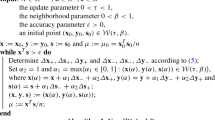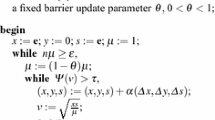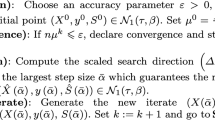Abstract
The interior-point algorithms can be classified in multiple ways. One of these takes into consideration the length of the step. In this way, we can speak about large-step and short-step methods, that work in different neighbourhoods of the central path. The large-step algorithms work in a wide neighbourhood, while the short-step ones determine the new iterates that are in a smaller neighbourhood. In spite of the fact that the large-step algorithms are more efficient in practice, the theoretical complexity of the short-step ones is generally better. Ai and Zhang introduced a large-step interior-point method for linear complementarity problems using a wide neighbourhood of the central path, which has the same complexity as the best short-step methods. We present a new wide neighbourhood of the central path. We prove that the obtained large-step primal–dual interior-point method for linear programming has the same complexity as the best short-step algorithms.

Similar content being viewed by others
References
Ai W, Zhang S (2005) An O\((\sqrt{n} {L})\) iteration primal–dual path-following method, based on wide neighborhoods and large updates, for monotone LCP. SIAM J Optim 16(2):400–417
Asadi S, Mansouri H, Zangiabadi M (2015) A class of path-following interior-point methods for \({P}_*(\kappa )\)-horizontal linear complementarity problems. J Oper Res Soc China 3(1):17–30
Asadi S, Zangiabadi M, Mansouri H (2016) An infeasible interior-point algorithm with full-Newton steps for \({P}_*(\kappa )\) horizontal linear complementarity problems based on a kernel function. J Appl Math Comput 50(1):15–37
Bai YQ, Lesaja G, Roos C, Wang GQ, El Ghami M (2008) A class of large-update and small-update primal–dual interior-point algorithms for linear optimization. J Optim Theory Appl 138(3):341–359
Darvay Z (2003) New interior point algorithms in linear programming. Adv Model Optim 5(1):51–92
Feng Z, Fang L (2014) A new O\((\sqrt{n}{L})\)-iteration predictor–corrector algorithm with wide neighborhood for semidefinite programming. Comput Appl Math 256:65–76
Illés T, Nagy M (2007) A Mizuno–Todd–Ye type predictor-corrector algorithm for sufficient linear complementarity problems. Eur J Oper Res 181(3):1097–1111
Illés T, Roos C, Terlaky T (1997) Polynomial affine-scaling algorithms for P\(^{*}\)(\(\kappa \)) linear complementary problems. Springer, Berlin, pp 119–137
Illés T, Nagy M, Terlaky T (2009) EP theorem for dual linear complementarity problems. J Optim Theory Appl 140(2):233–238
Illés T, Nagy M, Terlaky T (2010a) A polynomial path-following interior point algorithm for general linear complementarity problems. J Glob Optim 47(3):329–342
Illés T, Nagy M, Terlaky T (2010b) Polynomial interior point algorithms for general linear complementarity problems. Algorithm Oper Res 5(1):1–12
Karmarkar NK (1984) A new polynomial-time algorithm for linear programming. Combinatorica 4(4):373–395
Kheirfam B (2014) A predictor–corrector interior-point algorithm for \({P}_*(\kappa )\)-horizontal linear complementarity problem. Numer Algorithms 66(2):349–361
Kojima M, Megiddo N, Noma T, Yoshise A (1991) A unified approach to interior point algorithms for linear complementarity problems, volume 538 of lecture notes in computer science. Springer, Berlin
Lesaja G, Roos C (2010) Unified analysis of kernel-based interior-point methods for \(P_*(\kappa )\)-linear complementarity problems. SIAM J Optim 20(6):3014–3039
Li Y, Terlaky T (2010) A new class of large neighborhood path-following interior point algorithms for semidefinite optimization with \({O}\left(\sqrt{n}\log \frac{\rm {T}r(X^0S^0)}{\epsilon }\right)\) iteration complexity. SIAM J Optim 20(6):2853–2875
Liu C, Liu H, Cong W (2011) An \(O(\sqrt{n}L\)) iteration primal–dual second-order corrector algorithm for linear programming. Optim Lett 5(4):729–743
Liu H, Yang X, Liu C (2013) A new wide neighborhood primal–dual infeasible-interior-point method for symmetric cone programming. J Optim Theory Appl 158(3):796–815
Nagy M (2009) Interior point algorithms for general linear complementarity problems. PhD thesis, Eötvös Loránd University of Sciences, Institute of Mathematics
Peng J, Roos C, Terlaky T (2002) Self-regular functions: a new paradigm for primal–dual interior-point methods. Princeton University Press, Princeton
Pirhaji M, Mansouri H, Zangiabadi M (2017) An O\(\left(\sqrt{n}{L}\right)\) wide neighborhood interior-point algorithm for semidefinite optimization. Comput Appl Math 36(1):145–157
Potra FA (2002) The Mizuno–Todd–Ye algorithm in a larger neighborhood of the central path. Eur J Oper Res 143(2):257–267
Potra FA (2004) A superlinearly convergent predictor–corrector method for degenerate LCP in a wide neighborhood of the central path with O\(\left(\sqrt{n}L\right)\) iteration complexity. Math Program 100(2):317–337
Potra FA (2014) Interior point methods for sufficient horizontal LCP in a wide neighborhood of the central path with best known iteration complexity. SIAM J Optim 24(1):1–28
Potra FA, Liu X (2005) Predictor–corrector methods for sufficient linear complementarity problems in a wide neighborhood of the central path. Optim Methods Softw 20(1):145–168
Potra FA, Sheng R (1996) Predictor–corrector algorithm for solving \({P}_*(\kappa )\)-matrix LCP from arbitrary positive starting points. Math Program 76(1):223–244
Roos C, Terlaky T, Vial J-PH (2005) Theory and algorithms for linear optimization. Springer, New York
Sonnevend G (1986) An “analytic center” for polyhedrons and new classes of global algorithms for linear (smooth, convex) programming. In: Prékopa A, Szelezsán J, Strazicky B (eds) System modelling and optimization: proceedings of the 12th IFIP-conference held in Budapest, Hungary, September 1985, volume 84 of lecture notes in control and information sciences, pp 866–876. Springer, Berlin
Tar P, Stágel B, Maros I (2017) Parallel search paths for the simplex algorithm. Cent Eur J Oper Res 25(4):967–984
Wright SJ (1997) Primal–dual interior-point methods. SIAM, Philadelphia
Yang X, Liu H, Zhang Y (2015) A new strategy in the complexity analysis of an infeasible-interior-point method for symmetric cone programming. J Optim Theory Appl 166(2):572–587
Ye Y (1997) Interior point algorithms, theory and analysis. Wiley, Chichester
Acknowledgements
We thank the editor and the anonymous reviewers for the valuable suggestions that improved the presentation of the paper. The authors are also thankful for the support of the Babeş-Bolyai University and the Budapest University of Technology and Economics. Moreover, this work was supported by a grant of Ministry of Research and Innovation, CNCS—UEFISCDI, Project Number PN-III-P4-ID-PCE-2016-0190, within PNCDI III.
Author information
Authors and Affiliations
Corresponding author
Additional information
The paper was presented at the Special Section on IPM and Related Topics in Honor of Goran Lesaja at the 16th International Conference on Operational Research KOI 2016, Osijek, Croatia.
Rights and permissions
About this article
Cite this article
Darvay, Z., Takács, P.R. Large-step interior-point algorithm for linear optimization based on a new wide neighbourhood. Cent Eur J Oper Res 26, 551–563 (2018). https://doi.org/10.1007/s10100-018-0524-0
Published:
Issue Date:
DOI: https://doi.org/10.1007/s10100-018-0524-0




